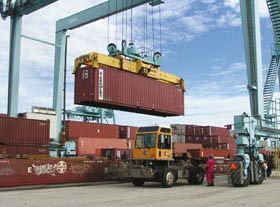Information
Major new rail and ship facilities on way for Jaxport
 The Port of Jacksonville enters 2010 with a view to its global future and a commitment to satisfy the immediate needs of its tenants and clients, says the chief commercial officer of Jaxport, Roy Schleicher.
The Port of Jacksonville enters 2010 with a view to its global future and a commitment to satisfy the immediate needs of its tenants and clients, says the chief commercial officer of Jaxport, Roy Schleicher.
During the past year Jaxport opened its TraPac Terminal and handed over the keys to Mitsui OSK Lines (MOL), completing its groundbreaking rapprochement with the Asian carriers of The New World Alliance – namely, APL, Hyundai Merchant Marine and MOL.
Mr Schleicher said the year ahead would bring an improved rail system for the Blount Island Marine Terminal and a significantadvancement in the dredge permitting process. However, the most import long-term issue would be selecting an engineering company to design the proposed Hanjin container terminal at Dames Point.
Bidding process
“The Hanjin process is our biggest thing in the bidding process,” said Mr Schleicher. He said the Board of Directors of the port authority had accepted the recommendation of its technical committee to retain Halcrow as the engineering company. Halcrow also carried out the engineering studies for the nearby TraPac Terminal.
Mr Schleicher said that in 2010 the Port would obtain authority from the Board to negotiate the cost of engineering as part of the design/build contract structure.
The TraPac Terminal is built on similar geology, but the Hanjin terminal operators want to use advanced automated container handling gantry cranes that travel on tracks, so the engineering design will be different.
“The rail-mounted gantries require a different type of science,” said Mr Schleicher.
The site of the proposed Hanjin terminal is the current location of the Port’s temporary cruise terminal. With an extensive parking lot, this site is far closer to being development-ready than the TraPac site was when engineering began. Nevertheless, says Mr Schleicher, no-one expects any shovels to be turned on the Hanjin project in 2010.
Financing
He said the engineering would be funded “through regular sources” without any need for bonding or other complex financing and without ‘stimulus funds’.
Meanwhile, the Port will continue to chase approvals for the planned dredging of the ship channel from Mile Point 14 past the Talleyrand Terminal, a real benefit for users of the Talleyrand Terminal including Mediterranean Shipping Company and Hamburg Süd.
Mr Schleicher said the Port was in the middle of a general re-evaluation report by the US Corps of Engineers that should be concluded in 2010. This would help move along the approvals and funding.
Improved rail
The workhorse Blount Island Marine Terminal – at 754 acres, the largest in Jaxport – is home to SSA Marine Terminal, Crowley and a major US Marine Corps staging terminal for Iraq and Afghanistan.
Cranes
Blount Island has one 100-ton Whirley crane and six container cranes (three of 50 tons capacity, one of 45 tons and two of 40 tons) with two additional cranes to be purchased this year. The efficient movement of cargo is facilitated by the terminal’s on-dock rail, served directly by CSX Corporation and served by rail-mounted gantries.
Those rail operations will be improved dramatically from the proceeds of an Economic Development Administration grant of US$6 million from the Department of Commerce. The grant will be used to rebuild existing track and rail ties, allowing Jaxport to enhance its global competitiveness and continue to create and retain private-sector jobs, according to Mr Schleicher.
The 14-mile, single-track rail system of Blount Island moves more than 30 per cent of all Blount Island cargo. However, the Blount Island rail system is over 40 years old and the grant project calls for portions of the existing track to be replaced. More than 19,000 linear feet (3.6 miles or 5.9 km) of new track will be laid. Over 12,000 timber ties (sleepers) will be replaced and 15 new turnouts (sets of points) will be constructed.
The Port will contribute $1.7 million to the project.










